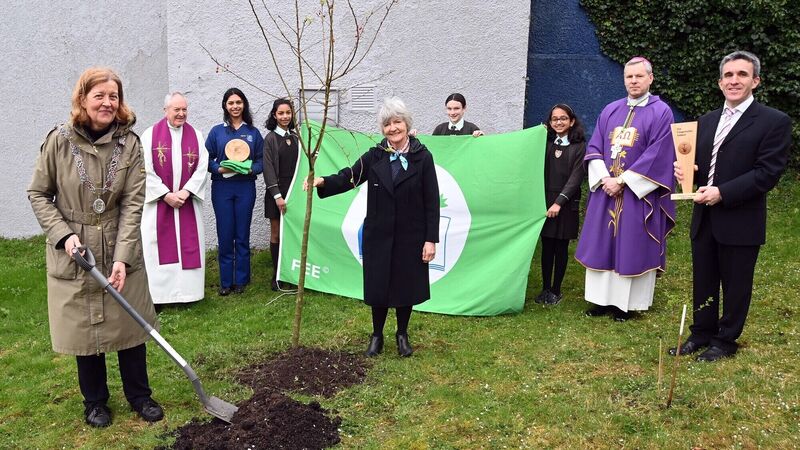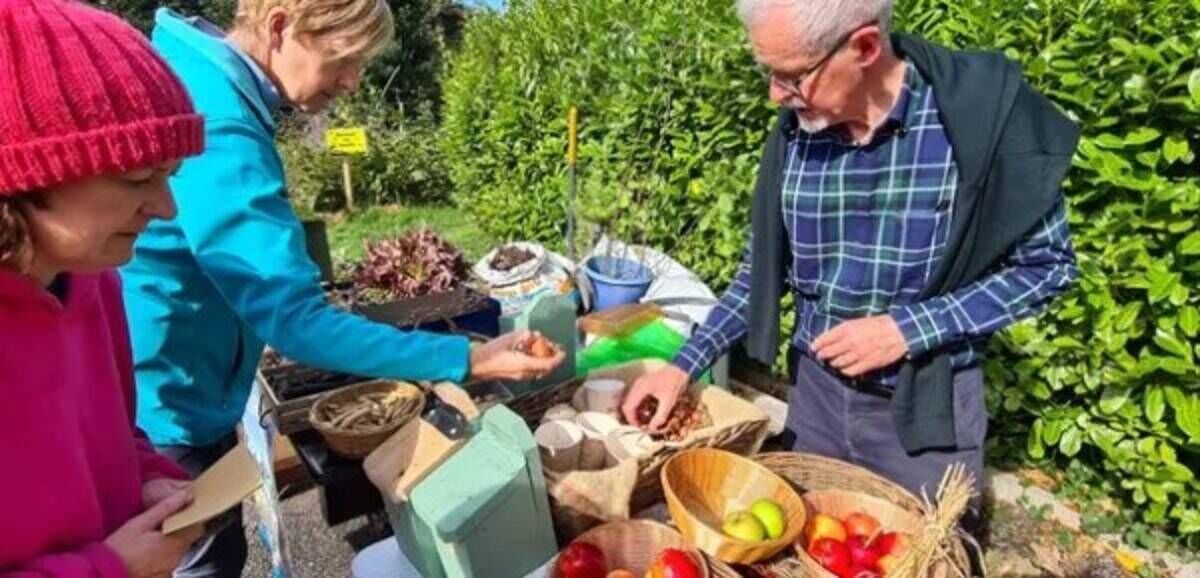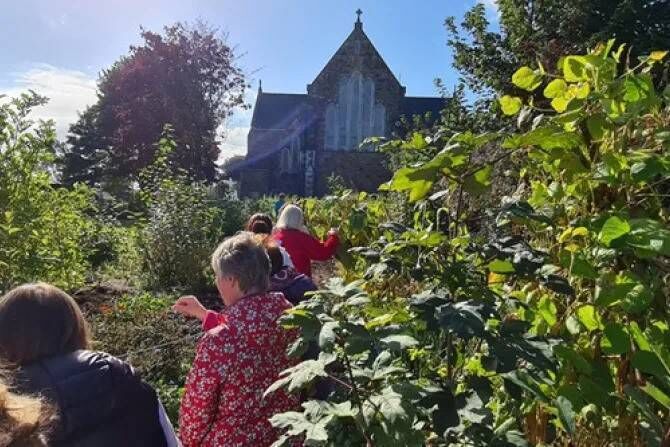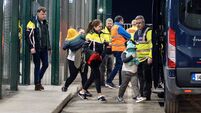Mass movement on climate change: The churches doing their bit for biodiversity

Councillor Colette Finn, far left, plants a crab apple tree in the new wildflower garden in the grounds of the Church of the Descent of the Holy Spirit, Dennehy's Cross, Cork. Picture: Denis Minihane
Something good is finally happening in nature across the country.
In parishes and church grounds throughout Ireland, biodiversity is becoming an important aspect of faith and community — a return to nature.
In early 2023, Irish bishops recommended that nearly a third of parish grounds should be given over as "a haven for pollinators and biodiversity" by the end of the decade.
The spring general meeting of the Irish Catholic Bishops’ Conference, citing the global biodiversity crisis, said providing 30% of parish grounds by 2030 was a way to "live out our vocation to be protectors of God’s handiwork".
Parishes, with Bishop Martin Hayes as coordinator for the Laudato Si’ Working Group (LSWG) of the Irish Bishops’ Conference, are being asked through their councils and diocesan trusts to identify suitable grounds for the biodiversity drive.
A landmark global agreement on biodiversity was signed in December 2022 at the UN’s Cop15 nature summit in Montreal as the crisis reaches a tipping point.
The most significant part of the Montreal agreement is a commitment to protect 30% of land and water considered important for biodiversity by 2030. At present, about 17% of terrestrial and 10% of marine areas are protected.
Irish bishops said they were inspired to act by the Cop15 agreement in Montreal, as well as Pope Francis' 2015 encyclical letter, Laudato Si’, which called for action to protect the natural world and act on climate change.
In Laudato Si’, Pope Francis reflected on the immense loss of biodiversity which is taking place around the world.
“The earth’s resources are also being plundered because of shortsighted approaches to economy, commerce, and production. The loss of forests and woodlands entails the loss of species which may constitute extremely important resources in the future, not only for food but also for curing disease and many other uses.
"Different species contain genes which could be key resources in years ahead for meeting human needs and regulating environmental problems,” he said.
Jane Mellett, church outreach manager with aid organisation Trócaire, said: “There is great work being done out there in parishes across the country. People are now in tune with the climate and biodiversity crises and they want solutions.
“Thankfully Laudato Si' is now better known now than it was five years ago. Hopefully we are at a stage where people want to do what they can.
"It’s a huge opportunity to nourish faith and spirituality through nature and God’s creation. It can really connect people back in.”
The Irish Catholic Bishops Conference website has a dedicated Return to Nature section that outlines the steps parishes can take to get involved.
The first piece of practical advice is to gather a group of interested people: “Invite your grounds keepers, parishioners, ecology groups, Tidy Towns group, local horticulturists, gardeners, beekeepers etc,” it says.
There are programmes on the website that act as a guide: The Faith Community Pollinator Plan, Gardening for Biodiversity, Actions for Pollinators, Flower-Insect-Timed Counts and more.

If parishes need inspiration from others, they can look at the example of Eco-Congregation Ireland (ECI), of which Ballineaspaig in Dennehy’s Cross in Cork is part.
ECI is an interdenominational project involving members of the Roman Catholic Church, Church of Ireland, Methodist Church, Presbyterian Church and Religious Society of Friends (Quakers) in Ireland.
It encourages churches of all denominations to take an eco-approach to worship, lifestyle, property and finance management, community outreach and contact with the developing world.
Ballineaspaig has been one of its flagship success stories, winning an Eco Gold Award.
The parish received its first Eco Award in 2015, in recognition of its promotion of environmental awareness and responsibility for the planet, its commitment to social inclusion, and its connection with the developing world through links with Turkwel parish in Kenya and as a Fairtrade parish.
In 2021, Ballineaspaig successfully applied to ECI for the newly introduced Gold Award, which was deferred until 2023 due to covid-19.
Examples of its activities include €136,000 being raised over the past three years to build a maternity unit, kitchen and fence in its sister parish Turkwel in Northern Kenya.
It also promotes Fairtrade products throughout the parish, has annual Lenten events on environmental issues, nature walks, and workshops on recycling, composting, raised bed planting, gardening, and vegetarian cooking.
In partnership with Cork City Council, it has erected two map information boards at the Curraheen River Walk, has registered with the Sustainable Authority of Ireland as a Sustainable Energy Community.

When it comes to biodiversity, it has established a wildflower garden in the church grounds, distributed free flower and vegetable seeds to parishioners, and has an annual harvest Thanksgiving celebration with local home-grown produce.
In Killorglin, Co Kerry, the parish biodiversity garden is one of the initiatives that has engaged the community.
Jane Mellett of Trócaire said it had been enthusiasm and drive that had led to Killorglin becoming an inspiration for other parishes.
A small group of volunteers cleared ground around the church to create a garden that is flourishing between pollinating, vegetable growing and tree planting, she said.
That kind of drive replicated throughout the estimated 1,355 parishes and more than 2,650 churches or Mass centres across the 26 dioceses of Ireland could make a huge difference to biodiversity in the country, Ms Mellet said.
“There is a Laudato Si working group for the Irish Bishops Conference and Trócaire is part of that. The Return to Nature project, when it was passed last March, we went to work on it because parishes are going to need a lot of resources.
“We got in touch with the National Biodiversity Data Centre [NBDC], the organisation that would have produced the Faith Communities Pollinator Plan. They organised a webinar for parishes to hear from the experts. It was really practical stuff that we will run again in January.
"What was really interesting with the webinar is what Kate Chandler of the NBDC said — you can still work with a car park.
“You can have planting, boxes, bird boxes, some parishes have gone down the road of beehives, there are lots of things you can do. It doesn’t necessarily mean you have to rip up a car park — even to stop spraying a car park is an action on its own to help biodiversity,” she said.
Strengthening the movement is the involvement of local authorities, according to Ms Mellett.
“The biodiversity officer in Clare got in touch with us because he was really excited about the possibilities. There are new biodiversity officers being hired by councils around the country, so that will be the plan for 2024.
“Barry O’Loughlin in Clare is piloting 10 parishes in Killaloe diocese for 2024. It’s hugely exciting, it’s still in the very early stages and we haven’t quite joined up all the dots yet, but we are getting there.
“The webinar will run again on January 17 and we’re going to encourage people to find out who their local biodiversity officer is.
“The Irish Catholic Bishops website is a great place to start. The amount of groups out there who would love to get stuck into this — the Tidy Towns and the like.
"There are great parishes out there that are the gold star eco-parishes. It can really be something that engages us in the world around us in the coming years.”
CLIMATE & SUSTAINABILITY HUB














